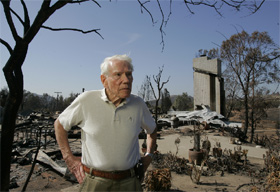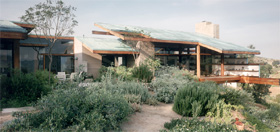SAN
DIEGO COUNTY WILDFIRES
'Wings' and, now, a prayer
Will award-winning custom home
rise from the ashes?
Roger M. Showley
STAFF WRITER
November 11,
2007
Richard Matheron, a retired U.S.
ambassador to several African countries, stepped gingerly
around the ruins of his 3,200-square-foot house overlooking
the San Pasqual Valley and declared the rebuilding effort
ahead as his next “adventure.“

CHARLIE
NEUMAN / Union-Tribune
All that's
left of Richard Matheron's 17-year-old house overlooking
the San Pasqual Valley is the chimney and a lap pool.
|
“That's the only way
to look at it,“ he said. “I'm determined not
to be depressed.“
Matheron's architect,
Norm Applebaum, also was looking to the future, even though
the ashes represented years of work on the home. The award-winning
house was completed in 1990 and had been featured in numerous
magazines and on two national TV shows. For him, losing the
home known as “Wings“ came as a nightmare already
lived. In 2003, one of Applebaum's other custom homes,
located in Poway, was destroyed in the Cedar fire.
“We're going to
work on the (design) program together and start another project,“Applebaum
said. “I won't do anything at all until they give
me a program -- so many bathrooms, so many bedrooms, the living
room, green materials --whatever it is.“

Kim Brun
Architect Norm
Applebaum designed the Matheron residence, known as
"Wings," as a projecting redwood sentinel looking out
over the San Pasqual Valley.
|
Every victim of last month's
fires has similar thoughts --to rebuild or not; to duplicate
the lost structure or do something quite different; to work
within the constraints of insurance proceeds or to invest
more.
Matheron, 80, said he and
his wife, Kay, are inclined to rebuild on the site, even though
he could imagine starting over in a high-rise condo downtown
within walking distance of Copley Symphony Hall.
“I've been lucky
to have a roof over my head,“he said, as he thought
back to his postings over a 30-year career as a foreign service
officer in Ethiopa, Swaziland and other places in Africa,
Asia and Europe. “I've seen so much suffering and
horror in the world ... I'm thankful that we don't
have the problems people have in the places where I've
served.“
What was special about the
Matheron house was its custom design suited to a setting reminiscent
of an African plain. The Matherons would entertain guests
by having them peer through a telescope at the exotic animals
on the open lands below, within the San Diego Wild Animal
Park, that resemble an African habitat. The couple also had
an extensive collection of African art and books.
“I had probably one of the
best collections of traditional African art in this part of
California,“he said. He had forgotten to toss some of
the items into the lap pool in the rush to evacuate.
“It's gone. There's
nothing you can say. I feel guilt in not being able to pass
on some of the objects to posterity.“
But he smiled when asked
if the next year or more of planning and rebuilding will require
multiple trips abroad to collect new items to put in the new
house.
And there are the new state-of-the-art,
high-tech gadgets to order and a chance to build in a sustainable
way. Long ago, Kay wrote a paper in high school about solar
power, and Richard said she will insist on installing photovoltaic
panels that had not become affordable in 1990.
“It'll give me
something to do,“he added, as his wife continues her
grant-writing job at Interfaith Community Services in Escondido.
The Matherons originally
found the site in 1981, when they were on leave from Swaziland
and touring of the Wild Animal Park.
Near the corner of Bandy
Canyon and Sky High roads, they spied a for-sale sign, checked
the price with local friends and real estate experts, and
bought the lot. In 1986, they were back for good and interviewing
architects.
Most pulled out their résumés
and portfolios but showed little interest in the site or the
Matherons' lifestyle, Matheron said. They should have
been more sensitive to the fact that Kay then worked for the
American Institute of Architects in Washington, D.C.
Then the couple came upon a house
designed by Applebaum in La Jolla and, while they worried
whether they could afford one of his designs, hired him in
1988 for what became a $600,000 project. Applebaum also became
a new best friend.
“When you hire an architect,
it's like getting married,“ Matheron said.
Three months after
the house was completed,
The San Diego Union's architecture critic, Kay Kaiser,
wrote a review, calling attention to the clear cedar siding,
corrugated steel roof painted the color of copper and the
light pine floor inside.
“Thanks to Applebaum's
light touch, they enjoy the rain on the metal roofs and Escondido's
occasional lightning storms,“ Kaiser wrote. “How
lucky they are to have found an architect who could connect
them to these primitive delights in a modern way.“
Over the 17 years they lived
in “Wings,“the Matherons entertained many guests;
her 99-year-old father, William Ellenberger, and a caregiver
lived in the Applebaum-designed guest house.
But on Monday, Oct. 22,
five days before the Matherons were set to fly to France and
while they were entertaining two house guests, all were ordered
to evacuate in advance of the firestorm sweeping down the
valley from Ramona.
“I'm going
to stay and fight it,“Richard told firefighters.
Their reply: “You'll
be all alone. There'll be no one to help you.“
The house guests left
immediately for a road trip up the coast; Ellenberger and
his caregiver drove to an interim location in north Escondido,
and Richard and Kay regrouped at a friend's Solana Beach
condo with a dozen other evacuees.
By Wednesday, they learned
their house had been consumed by the fire. On Thursday, they
ventured back to the site to see for themselves.
“We were prepared
to cry. We were prepared to lose everything,“Matheron
said, but there were no tears as he surveyed the total loss.
He likened it to a scene from Hiroshima, Japan, after the
atomic bomb struck in 1945.
“t's so horrible,
it's beautiful,“ Richard recalled thinking.
The corrugated roof had
collapsed and buckled into a shape reminiscent of a Frank
Gehry design. A long steel beam lay across the living room
space, bent 15 degrees from the heat. Succulents and an assortment
of California native plants and African species were singed
with perhaps had some life still.
Applebaum met the couple
two days later and helped salvage a few objects from the ashes.
There were hugs all around.
The architect said he
maintains a proprietary interest in each of the many homes
around the country he has designed, including a Rancho Santa
Fe residence listed by the tax assessor as the county's
most expensive residence.
“They're like
children to me,“ Applebaum said of his houses. “It's
very, very tough.“
An advocate of plentiful
use of wood and glass, Applebaum said he would investigate
incorporating more fire-resistant materials. He's currently
reviewing the original building plans to provide a replacement
cost estimate for the family's insurance carrier. Building
an all-concrete house was considered 20 years ago but deemed
too costly.
“Fire itself is
so powerful,“Applebaum said. “I don't think
even a concrete house, if it heats up enough (would survive).
You'd lose its strength.“
As Matheron left his
dream house-turned-nightmare, an African statue head from
Ouagadougou, Burkina Faso, in west Africa, seemed to bid a
silent farewell from a step where it had been set down after
the fire.
“He always looked
sad,“ Matheron said. “Now, he looks sadder.“
Roger M. Showley: (619) 293-1286;
roger.showley@uniontrib.com
Home editor Carl Larsen contributed to this report.
|